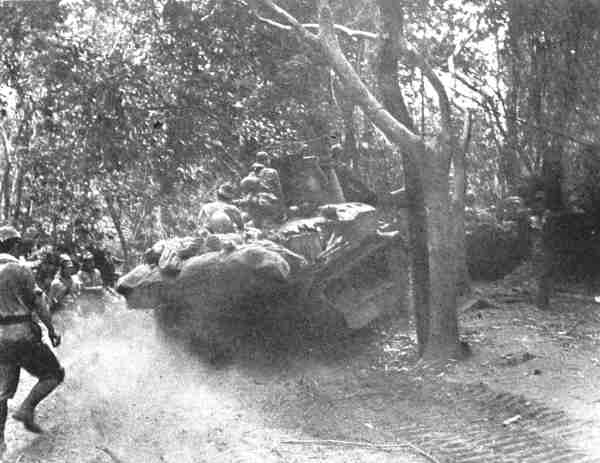The Last Line at Cabcaben
As he died to make men holy,
let us live to make men free,
While God is marching on.
—Julia Ward Howe, “Battle Hymn of the Republic”
Although no American reinforcements arrived, reinforcements did come to the Japanese. By early 1942, the Japanese reinforced their hold in the Philippines with some of their most experienced troops. In April the Japanese launched a drive south down the peninsula. On April 7, after two days and nights of continuous shelling and air attacks, the Japanese infantry units broke through Filipino and American lines in the north and poured south.[1] One soldier described the retreating army as a “tired mob trying to keep out of the way of an annihilating steamroller.”[2]
 On April 7, 1942, a heavy Japanese armored attack broke through the American-Filipino defenses.”
On April 7, 1942, a heavy Japanese armored attack broke through the American-Filipino defenses.”
With the front lines broken and the Japanese heading south, the 200th and the 515th were ordered to destroy their antiaircraft guns and take up rifles as infantrymen and defend the line south of Cabcaben Airfield, the last line of defense. Officially, the units were combined and reconstituted as the Provisional Coast Artillery Brigade.[3]
Hamblin was among those of the 200th now headed to the front as part of the infantry. He handed his rifle to a friend on a truck about to depart for the front only to have the truck leave while he turned around to get his pack. He nevertheless started marching toward the front without a rifle and against a tide of fleeing civilians and soldiers “staggering from wounds, exhaustion, and lost hope.” Hamblin managed to “liberate” a rifle from a Filipino, “moving so fast in the other direction, I figured he wouldn’t have any use for it.”[4] Despite the Japanese onslaught and the chaos of the retreat, the combined 200th/
Hamblin later wrote of his thoughts that last evening. A captain had assigned him as his “runner” to take messages to his command post. Returning to the command post, Hamblin came across a spot where the air corps had just abandoned their own command post. A radio was tuned to a Manila station, then under Japanese control, playing a Japanese propaganda program dedicated to the “Americans on Bataan.” The songs included “Waiting for Ships that Never Come In,” and “Aloha Oe,” among other appropriate tunes. Hamblin wrote of that moment, “I thought of home and it was hard to realize that I was seven thousand miles away, and these things were happening to me. I was brought back to reality by the sound of motors and I realized it was our few remaining aircraft . . . preparing to fly south and escape the advancing army. . . . I strained my ears to hear the sound as long as I could, because I knew it would be the last friendly planes I would hear for a long time, then there was silence, broken by the sound of the jungle night.”[6]
He also heard the sound of ammunition dumps being blown up—the tremendous rumbling of the detonation of TNT and hundreds of thousands of rounds of ammunition to prevent their capture by the Japanese. It was the end. Ironically, and perhaps as an omen, this same night a strong earthquake struck the Philippines with its epicenter in Bataan.[7]
Surrender
On President Roosevelt’s order, General MacArthur secretly left for Australia on March 12, 1942. Along with his family and some staff officers, General MacArthur departed Corregidor on four PT boats for the island of Mindanao in the south. From there, they were taken to the Del Monte Airfield, where the Fifth Air Base group was stationed. Around 2 a.m. on March 16, the group left in two planes for Australia. Private James Patterson, a Latter-day Saint soldier in the Fifth Air Base, was at Del Monte at the time and near the general when he boarded the plane. He heard General MacArthur promise, “I shall return.” As one who was staying, Patterson was not particularly impressed. On arriving in Australia, General MacArthur again made his famous pledge, “I shall return,” which was largely met with derision among the American troops on Bataan.[8]
With General MacArthur gone, General Jonathan Wainwright crossed over from Bataan to Corregidor to assume command of the Philippines; General Edward King took General Wainwright’s place as commander on Bataan.[9] With more provisions and protection within the tunnels, those on Corregidor could hold out a while longer, possibly a month or more. But on Bataan General King knew that it was over. With his troops simply unable to defend against the Japanese attacks, he would be the one to have to surrender. As General King put it in a memo, “The physical condition of the command due to the long siege, during which they have been on short rations, will make it very difficult to move them a great distance on foot.”[10] That was a gross understatement. Unit commanders were estimating their combat efficiency, the percentage of soldiers able to perform minimal combat functions, at 25 percent and declining.[11]
General King’s surrender was complicated by the fact that President Roosevelt, General George Marshall, General MacArthur, and General Wainwright had all given orders not to surrender under any circumstances. General King assumed he would be court-martialed after the war for his actions, and he insisted on acting alone so that no one else—including General Wainwright, General MacArthur, or General Marshall—would be “saddled [with] any part of the responsibility.”[12]
Normally, before surrender, the surrendering troops would destroy anything of potential value to the enemy, such as weapons, ammunition, vehicles, and fuel. When General King ordered such destruction in anticipation of the surrender, however, he reserved a significant number of vehicles and gasoline for the purpose of transporting US troops. He hoped the Japanese would accept his proposal to transport his own debilitated troops to whatever destination the Japanese would designate, as he (quite correctly) believed the Japanese did not have sufficient vehicles to transport such a large number of prisoners—and if they did, they would not use them for that purpose.[13] General King’s decision to reserve some transport vehicles from destruction would turn out to have important consequences for Lieutenant Bobby Brown, as he was in charge of some transport vehicles at the time of the surrender.
General King surrendered on April 9, 1942. The surrender ceremony did not go well. The Japanese officer accepting the surrender on behalf of General Masuhara Homma, the commander of the Japanese 14th Army, was angered that General King did not have authority to surrender all of the Filipino and American forces (in other words, those on the key island of Corregidor as well). General King asked that his troops be permitted to march out of Bataan under their own officers to whatever location the Japanese designated and that the sick, wounded, and exhausted men be allowed to ride in vehicles he had saved for that purpose.[14] In answer to that request, the officer simply replied, “The Imperial Japanese Army are not barbarians.”[15] With no alternatives left, General King agreed to an unconditional surrender. Brown, Hamblin, Davey, and the others became prisoners of the Imperial Japanese Army on April 9.
Notes
[1] Shively, Profiles in Survival, 40–46; Morton, Fall of the Philippines, 442–48.
[2] Stephen M. Mellnik, Philippines War Diary, 1939–1945, revised edition (New York City: Van Nostrand Reinhold, 1969), 111.
[3] Morton, Fall of the Philippines, 451, 454; Shively, Profiles in Survival, 46.
[4] Cave, Beyond Courage, 103, 146–47.
[5] Mellnik, “The Life and Death of the 200th Coast Artillery.”
[6] Hamblin, “My Experience,” 7.
[7] Morton, Fall of the Philippines, 459–60.
[8] Morton, Fall of the Philippines, 359; Lukacs, Escape from Davao, 54; Patterson, interview, 13–14. Allen C. Christensen also notes in his history that he was on machine gun duty the night General MacArthur left; see Christensen, “My Life History,” 7.
[9] Morton, Fall of the Philippines, 365.
[10] Sides, Ghost Soldiers, 46.
[11] Shively, Profiles in Survival, 38; Morton, Fall of the Philippines, 384.
[12] Shively, Profiles in Survival, 47.
[13] Morton, Fall of the Philippines, 457, 466; Hamblin, “My Experience,” 8.
[14] Morton, Fall of the Philippines, 465–66.
[15] Lukacs, Escape from Davao, 56.
